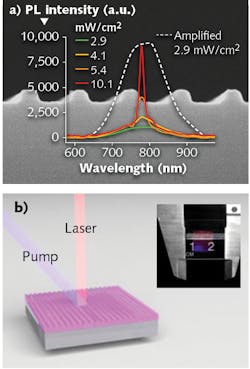While hybrid lasers are feasible as light sources for integrated silicon photonics, they are complicated to fabricate—in contrast, all-silicon lasers are potentially much simpler to make. Researchers at Fudan University (Shanghai, China) have overcome the traditional low gain and broadband transmission characteristics of pure silicon sources by using silicon nanocrystals and an optimized distributed feedback (DFB) cavity to create a high-gain optically pumped all-silicon laser.
Key to their achievement was the development of high-gain, high-spatial-density silicon nanocrystals (Si NCs) through prolonged hydrogen passivation of the active Si NC layer under high pressure and at relatively low temperature. The active Si NC layer was obtained through the phase-separation annealing of hydrogen silsesquioxane (HSQ). The high-pressure, relatively low-temperature passivation process enabled formation of Si NCs with high gain comparable to gallium arsenide (GaAs) and indium phosphide (InP). The second-order DFB Bragg grating cavity was formed on the active layer using nanoimprint lithography to pattern the active Si NC layer such that the resonant wavelength is matched to the emission peak of the gain medium (around 770 nm).
At a femtosecond-pulse pump power density of 10.1 mW/cm2, spectral narrowing is enhanced as the optical gain increases as a function of passivation time (from 0 to 240 hours). Lasing characteristics—the threshold effect, polarization dependence, significant spectral narrowing, and small spread of divergence angle of stimulated emission—were achieved, suggesting the realization of an optically pumped all-Si laser. Typical emission parameters are 6–12 nm full-width half-maximum spectral widths for 760–770 nm sources and a surface-emitting beam divergence of less than 2°. Reference: D.-C. Wang, Sci. Bull., 63, 75–77 (2018).

Gail Overton | Senior Editor (2004-2020)
Gail has more than 30 years of engineering, marketing, product management, and editorial experience in the photonics and optical communications industry. Before joining the staff at Laser Focus World in 2004, she held many product management and product marketing roles in the fiber-optics industry, most notably at Hughes (El Segundo, CA), GTE Labs (Waltham, MA), Corning (Corning, NY), Photon Kinetics (Beaverton, OR), and Newport Corporation (Irvine, CA). During her marketing career, Gail published articles in WDM Solutions and Sensors magazine and traveled internationally to conduct product and sales training. Gail received her BS degree in physics, with an emphasis in optics, from San Diego State University in San Diego, CA in May 1986.
